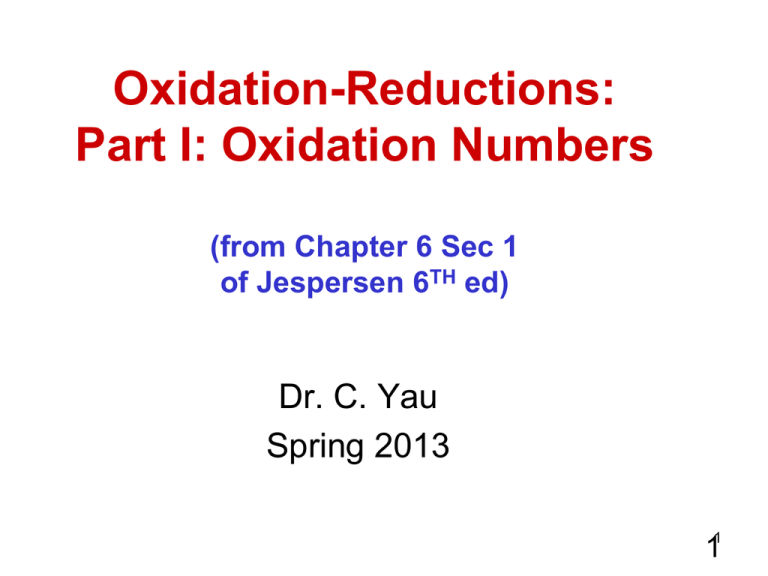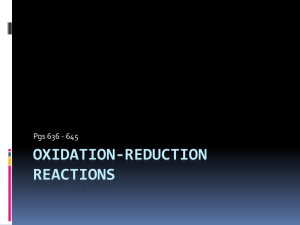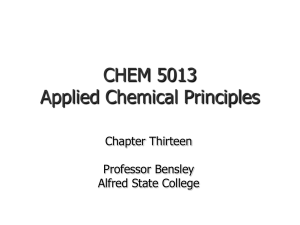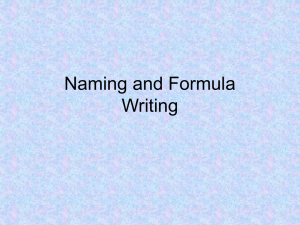Oxidation Numbers - CCBC Faculty Web
advertisement

Oxidation-Reductions: Part I: Oxidation Numbers (from Chapter 6 Sec 1 of Jespersen 6TH ed) Dr. C. Yau Spring 2013 11 What are oxidation-reduction reactions? "Oxidation-reduction" reactions are commonly called "redox" reactions. Remember: Acid-base rxns involve a transfer of H+ or proton. Redox rxns involve a transfer of electrons. 22 Oxidation Numbers To understand redox, first you must learn to assign oxidation numbers. Oxidation numbers are hypothetical charges assigned to each atom. Each atom, even in molecular substances that have no ions, is assigned a charge. Note: The charge is hypothetical. Oxidation numbers is only for "book keeping" to keep track of electrons. 3 Assigning Oxidation Numbers LEARN THESE RULES IN ORDER! 1. Oxidation # of any free element is zero. e.g. H in H2, P in P4 are assigned zero. 2. Oxid # of simple monatomic ions is the charge of the ion. e.g. In MgCl2, Mg is +2. Cl is -1. In SnS, Sn is +2 and S is -2. 44 Assigning Oxidation Numbers 3. In its cmpd, F is assigned -1. 4. In its cmpds, H is +1 unless it is bonded to a metal, where it is -1 (as in hydride H-) e.g. In HCl, H is +1 and Cl is -1. In MgH2, Mg is +2 and H is -1. 5. In its cmpds, O is -2 unless it is a peroxide. eg. in MgO, Mg is +2, O is -2. In hydrogen peroxide (H2O2), H is +1 and O is -1. 5 Assigning Oxidation Numbers 6. Oxid # of others are generally calculated from knowing that the sum of all charges must add up to charge of substance. For example, In HClO, sum of charges = 0 +1 ? -2 H is assigned +1, O is assigned -2. Cl is calculated to be +1 in order for the sum to be zero. In the chlorite ion, ClO2-, sum of charges = -1 ? -2 Oxygen is assigned -2, what must Cl be in order for net charge to be -1? Ans. Cl = +3 6 Example 6.2 Titanium oxide, TiO2, is a white pigment used in making paint. A now outmoded process of making TiO2 from its ore involved Ti(SO4)2. What is the oxidation number of titanium in Ti(SO4)2? Example Determine the oxidation numbers of atoms in oxygen difluoride. When there is conflict, apply the rules starting from the top (Rule #1 and down). 7 Example 6.4 The air bags used as safety devices in modern autos are inflated by the very rapid decomposition of the ionic compound sodium azide, NaN3. The rxn gives elemental sodium and gaseous nitrogen. What is the average oxidation # of the nitrogen in sodium azide? How can we have a fractional charge? Remember these are hypothetical charges only. Do Pract Exer 3, 4, 5 p.181 8 Assign Oxidation # Do not confuse oxidation # with overall charge. We assign oxidation #’s to EACH element, and it is the charge per atom. a) SO42O is -2 and S is +6 b) NH4+ For the rest, jot down what you think the c) CoBr3 answers are and then d) Fe(NO3)2 check them at my e) CrClO3 CHEM 121 webpage under ANSWERS. f) V2(OH)3 9 Oxidation # is to identify oxidation & reduction. Redox MUST have a change in oxidation numbers in at least two of the atoms. One MUST increase (oxidation). LEARN The other MUST decrease (reduction). THESE TERMS H2 + Cl2 2 HCl 0 0 +1 -1 Oxid # of H increased from 0 to +1 (oxidation) Oxid # of Cl decreased from 0 to -1 (reduction) We say H2 is oxidized and Cl is reduced. We say H2 has undergone oxidation and Cl has undergone reduction. An oxidizing agent causes others to be oxidized and is itself reduced. (Cl is reduced and therefore it is the oxidizing agent.) A reducing agent causes others to be reduced and is itself oxidized. (H is oxidized and therefore it is the reducing 10 agent.) Recognizing Redox Rxns Example 6.5 p. 220 Is the following a redox rxn? If so, identify the substance oxidized and the substance reduced as well as the oxidizing and reducing agents. 2KCl + MnO2 +2H2SO4 K2SO4 + MnSO4 + Cl2 + 2H2O Do Pract Exer 8, 9, 10, 11 on p. 221. 11 Recognizing Redox Rxns Is the following a redox rxn? Na2CO3 + 2HCl 2NaCl + CO2 + H2O 12











